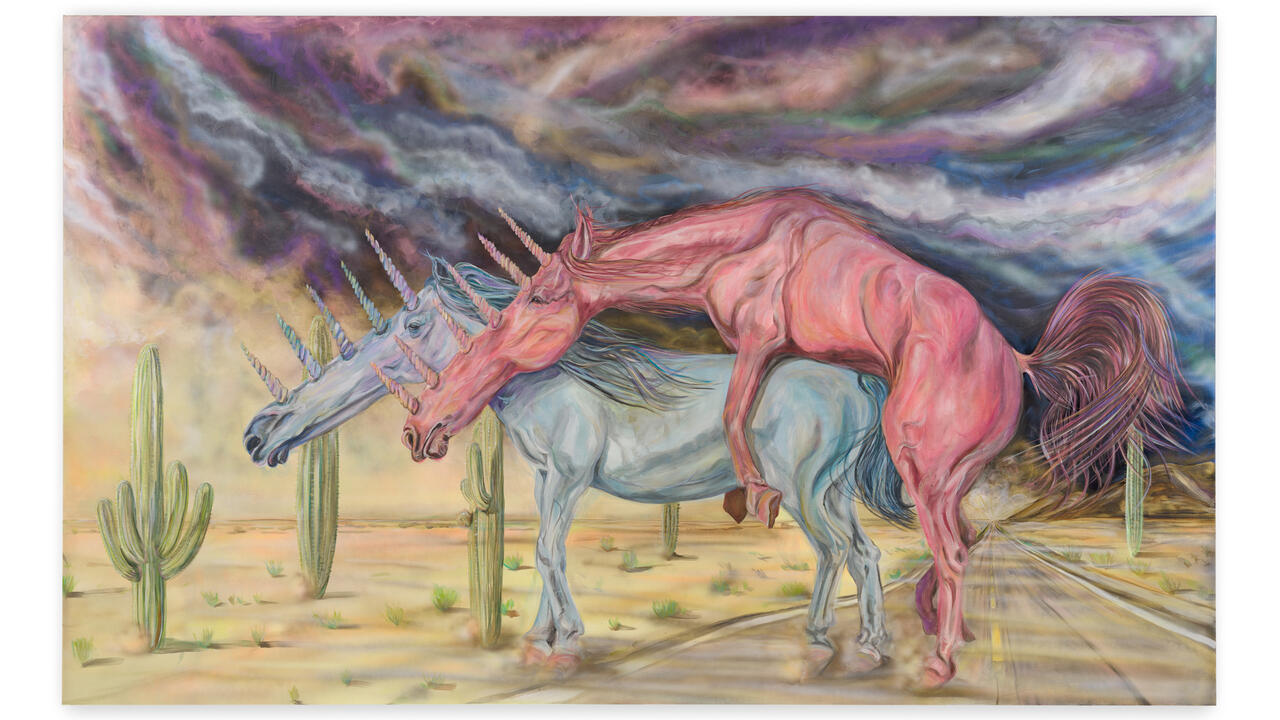Zhang Xiaogang and the Different Shapes of Class Ideology
At Pace Gallery, New York, a new series shows the artist’s personal exploration of the Mao era and its traces in the present day
At Pace Gallery, New York, a new series shows the artist’s personal exploration of the Mao era and its traces in the present day

Rising to prominence in the 1990s as a seminal figure in contemporary Chinese art, Zhang Xiaogang is best known for his ongoing ‘Bloodline’ portraiture series, which typically depict families drained of colour, with placid, emotionless faces, as well as eerie translucent marks that stamp each painting like birthmarks. After stumbling across old photographs of his parents and siblings posing rigidly for the camera, the artist developed a consistent method to represent the archetype of the Mao-era family and process his memories of the Cultural Revolution and its traumatic aftermath.
In ‘Recent Works’ at Pace Gallery, Zhang makes a concerted effort to break out of the rectangular canvas, incorporating shapes that toy with flatness and three-dimensionality. For example, Mirror No. 2 (all works 2018) takes the form of two oval shapes joined in the middle, referencing pendants that open to reveal two secret photographs. On the right is the artist’s mother, clad in classic Maoist uniform and portrayed in grey-tone; on the left is a lavish, period-specific chandelier hanging above a bathtub, painted in full color. Juxtaposing a paradigmatic Communist figure with material luxuries that only high-standing officials could afford at the time, the work grapples with internal conflicts within manifestations of class ideology.

Zhang also uses collage techniques and a range of materials to further illustrate the fragmentation and sedimentations of memory. Layers of paper are glued together on works, with hand-ripped, jagged edges that seem to indicate the lack of defined boundaries when recalling the past. Some of the paintings feature old magazine or newspaper clippings, most of which are rendered illegible. Among these faded texts and images, what stood out in particular was a Chinese report on Bob Dylan’s 30th anniversary concert at Madison Square Garden, romantically captioned ‘Forever Young’. Evidently, the influx of Western pop culture – facilitated by China’s economic ‘Reform and Opening-Up’, which began in 1978 – formed a significant part of the artist’s deep nostalgia for this transitional period.

Ironically, the pieces of cotton ropes and electric wires that Zhang chose to include as collage elements, do not actually connect anything, serving a purely ornamental function. It is precisely the failure to temporally bridge the past and present that explains the suspension of time and space – a distinctive feature of these recent works. Despite the attempt to experiment with different techniques and materials, Zhang’s subject matter remains caught within a loop of melancholia, whether the triptych of antiquated thermos water bottles (Three Thermos Bottles) or a young boy holding up a red banner signifying collective honour (Man on a Stool No. 2). Already in 1994, critic Wang Lin had pointed out that artist practices driven by a certain ‘Mao-era complex’ indeed pandered to the West’s obsession with Cold War antagonisms, largely for increasing their international repute or commercial marketability. Yet, more than twenty years later, Zhang seems unable to part with a repertoire of symbols irrefutably tied to a Chinese socialist context.
Perhaps Jump No. 2 could be interpreted as a subconscious manifestation of a psychic state of immobility. What appears to be a figure – bearing striking resemblances to the artist – leaping in mid-air, is in fact permanently suspended, neither jumping up nor falling down: his eyes shut, clothes undisturbed, enclosed in an eternal dreamscape.
Zhang Xiaogang,‘Recent Works’ runs at Pace Gallery, New York, until 20 October 2018.
Main image: Zhang Xiaogang, Bathtub (detail), 2018, oil on paper with magazine and cotton rope collage, 144 cm × 203 cm. Courtesy: the artist and Pace Gallery






















